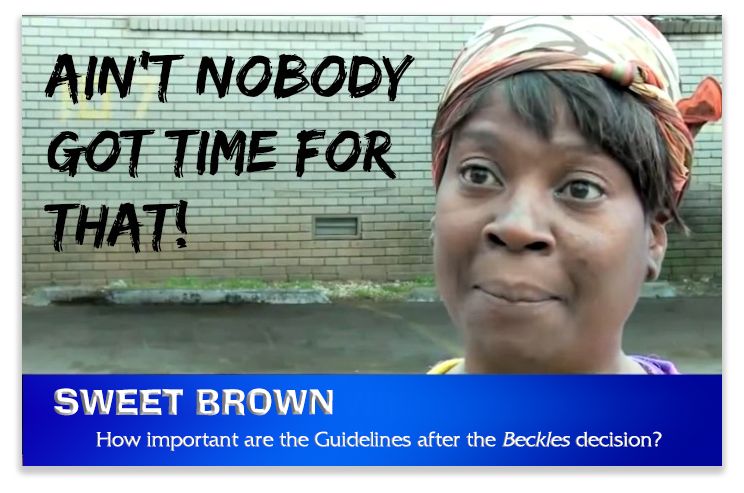We post news and comment on federal criminal justice issues, focused primarily on trial and post-conviction matters, legislative initiatives, and sentencing issues.
 Today, we offer a few kibbles of legal interest that have been cluttering our dog pound for the last few days…
Today, we offer a few kibbles of legal interest that have been cluttering our dog pound for the last few days…
US ATTORNEYS TO FOCUS ON VIOLENT CRIME, WHICH INCLUDES DRUG TRAFFICKING
There is some indication that the Trump Administration may be expanding violent crime enforcement activities, a category which Attorney General Jeffrey Sessions believes must include gun and drug offenses. In keeping with the President’s fixation on violent crime, Sessions last week ordered United States Attorneys to work with with local and state prosecutors “to investigate, prosecute and deter the most violent offenders.”
Sessions’ directive said, “federal prosecutors should coordinate with state and local counterparts to identify the venue (federal or state) that best ensures an immediate and appropriate penalty for these violent offenders.”

In keeping with the new emphasis on violent crime, Sessions has appointed Steve Cook, chief of the Criminal Division for the U. S. Attorney’s Office for the Eastern District of Tennessee, and one of last year’s most vocal opponents of sentencing reform, as associate deputy attorney general with a mandate to focus on violent crime. Cook told a newspaper last year, “When you put criminals in jail, crime goes down. That’s what incapacitation is designed to do, and it works.” He called the idea that most offenders in federal prisons are nonviolent drug pushers is a myth.
 Some critics the emphasis on violent crime as federal encroachment. “An expanded federal criminal justice agenda comprised of federal-state-local task forces targeting violent offenses and coupled with tougher federal sentences would be a substantial change in practice and a step in the wrong direction,” says Ryan King, senior fellow at the Urban Institute Justice Policy Center.
Some critics the emphasis on violent crime as federal encroachment. “An expanded federal criminal justice agenda comprised of federal-state-local task forces targeting violent offenses and coupled with tougher federal sentences would be a substantial change in practice and a step in the wrong direction,” says Ryan King, senior fellow at the Urban Institute Justice Policy Center.
Tougher sentences could quickly reverse declines in BOP inmate population, especially in higher-level joints. According to a new Prison Policy Initiative report, 50% of the 189,000 federal prison inmates were convicted of drug offenses. Violent-crime convictions account for just 7% of the federal total.
The Crime Report, At ‘critical moment’ under Trump, report gives hard facts on incarceration (Mar. 14, 2017)
The Trace, Meet the hardliner Jeff Sessions picked to carry out his violent crime crackdown (Mar. 15, 2017)

WE’VE GOT YOUR NUMBER
The U.S. Sentencing Commission last week released its 21st annual Sourcebook of Federal Sentencing Statistics, covering fiscal year.
 The current-year book is available online as an interactive book that defies downloading. It contains a wealth of sentencing stats broken down in over 100 tables (as well as sentencing date by federal district, another 97 tables).
The current-year book is available online as an interactive book that defies downloading. It contains a wealth of sentencing stats broken down in over 100 tables (as well as sentencing date by federal district, another 97 tables).
Slogging through the Sourcebook takes awhile, but it yields a lot of fascinating data. Of special interest:
• the number of cases ending with guilty pleas remained steady at 97%
• offenses included 32% drug, 30% immigration, white-collar (including fraud) 13%, guns 11%, child porn 3%.
• 14% of people challenging their sentences on direct appeal won reversal, but only 5% ended up with a better sentence.
• two out of three resentencings resulted from the 2-level reduction for drug offenses, Rule 35(b) reductions for helping the government were 11% of resentencings, and 10% were from wins on 2255 motions.
• continuing the pathetic performance on compassionate release, the courts granted a total of 51 inmates sentence reduction (a mere 0.4% of all resentencings).
• in new sentencings last year, 49% were within the Guidelines range, a two-percent increase over last year. Only 2% of sentences were above the range, while 19% were below the range for reasons other than government motion. About 20% of sentences were reduced because the defendant helped the government, and another 9% were cut for early disposition of an immigration case.
U.S. Sentencing Commission, Sourcebook of Federal Sentencing Statistics 2016 (Mar. 12, 2017)

PLEA BREACHES AND PLAIN ERROR
Like 97% of other federal defendants, Jim Kirkland made a deal with the government to plead guilty. In exchange, the government agreed to recommend the bottom of the guidelines range at sentencing.
But when Jim stood in front of the judge, the government went crazy on him, not just failing to recommend the bottom, but instead pushing for the very top, and bringing in live testimony of how terrible a few of his prior state crimes had been. The probation officer recommended the dead center of the sentencing range, and the judge gave it to him, saying that was what he had had in mind all along.
 Jim’s sentencing lawyer must have been snoring too loudly to object, but on appeal, Jim raised the government’s plea breach. The AUSA admitted it was a plain breach, but argued the error did not affect Jim’s substantial rights or seriously affect “the fairness, integrity, or public reputation of judicial proceedings,” two of the standard Jim had to meet before proving F.R.Crim.P. 52(b) “plain error.” The government’s rationale was that the district judge said he said the 300-month midpoint sentence “frankly, happens to coincide with my own independent decision,” and that was sufficient evidence that the court would have imposed the same exact sentence even if the AUSA had recommended the bottom of the guidelines.
Jim’s sentencing lawyer must have been snoring too loudly to object, but on appeal, Jim raised the government’s plea breach. The AUSA admitted it was a plain breach, but argued the error did not affect Jim’s substantial rights or seriously affect “the fairness, integrity, or public reputation of judicial proceedings,” two of the standard Jim had to meet before proving F.R.Crim.P. 52(b) “plain error.” The government’s rationale was that the district judge said he said the 300-month midpoint sentence “frankly, happens to coincide with my own independent decision,” and that was sufficient evidence that the court would have imposed the same exact sentence even if the AUSA had recommended the bottom of the guidelines.
Last week, the 5th Circuit agreed with Jim. Clearly unhappy at the government’s breach of its promise, the Court said “the government did not merely recommend a high-end sentence but also strongly argued and presented testimony in support of that recommendation, recounting in great detail the graphic and… explicit facts involved in Kirkland’s offense of conviction and a prior offense and emphasizing his criminal history and his violation of the conditions of his supervised release. The testimony and argument by the Government filled more than nine pages of the sentencing transcript. Therefore, the district court may have been influenced not only by the Government’s recommendation, but also by Government’s passionate emphasis of aggravating factors in support of that recommendation, which brought public safety concerns to the forefront.”
When the government breaches a plea agreement, a defendant may either ask the court to order specific performance of the plea agreement and resentencing before a different judge, or withdrawal of the guilty plea. Jim asked for and got resentencing before a new judge.
United States v. Kirkland, Case No. 16-40255 (Mar. 17, 2017)
– Thomas L. Root














